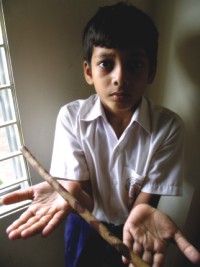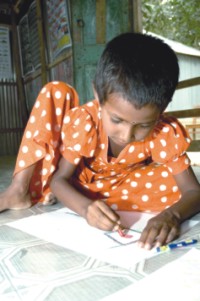|
In Focus
Children need Protection
Syeda Shamin Mortada
"The way a society treats its children reflects not only its qualities of compassion and protective caring, but also its sense of justice, its commitment to the future and its urge to enhance the human condition for coming generations.”
--Javier Perez de Cuellar, Former Secretary General of the United Nations.
 |
Corporal punishment such caning is a form of violence widely accepted in many societies |
Our society severely lacks all such qualities and the future of the coming generation is in serious jeopardy. Violence against a child may be verbal, physical, emotional, mental, psychological or even sexual and it may occur anytime and anywhere at home, in school, institutions such as orphanages, children's home, detention centres, etc., workplace or in the community.
The United Nation's Secretary General's Study on 'Violence Against Children' found that violence against children exists in every country of the world, regardless of culture, ethnic group, background or status. However, much violence against children remains hidden and sometimes it is socially approved. Many horrific incidents remain hidden because of the victim's fear of stigma and isolation; at times the act is done by someone powerful who may repeat the act of harming. Thus often violence is not reported and at times if reported then not recorded. Some form of violence which is accepted in many societies include forced or early marriage--82 million girls across the globe marry before 18 years mostly to much older men, and face violence yet again, including forced sex. Female genital mutilation, honour killings are common crimes in many countries as are other cultural practices that translate to violence against children. Around 100 to 140 million girls have undergone some sort of female genital cutting and in the Sub-Saharan Africa, Egypt and Sudan, 3 million girls and women are subjected to this practice every year.
The World Health Organization (WHO) estimated that almost 53,000 children were murdered worldwide in 2002. It also said that 150 million girls and 73 million boys under 18 were forced to have sex or experienced other forms of sexual violence during 2002.The study found that between 1% to 21% of girls had been sexually abused by the time she reached 15. A survey from a wide range of countries found that between 20% to 65 % school aged children reported to have been bullied, verbally or physically. The International Labour Organization (ILO) estimated that in 2004, 218 million children were involved in child labour, 126 million of whom were doing hazardous work. It further added that 5.7 million children worked as forced or bonded labour, 1.8 million in prostitution and pornography and 1.2 million were victims of trafficking.
Bangladesh, despite being a signatory to child rights conventions, does not have a very good track record regarding violence against children. Girls are more vulnerable than boys.
A girl from an influencial family was raped by her religious teacher (Hujur) twice, at the age of seven. He put his hand on her mouth to prevent her from screaming out. The child never mustered up the courage to tell the parents about the happenings as the teacher forbade her to do so.
Another girl from a slum area was repeatedly sexually assaulted by her father. She and her parents shared one room and the father took advantage of the situation. The mother tried to end the evil activities by partitioning the room and sending her child to the other end. Yet, it never stopped. The girl had to run away and managed to take shelter in an NGO.
According to a 13-year- old street worker: “The police ask for bribes, snatch our money and if you do not pay them, you cannot work. When they get bored they kick us while we are sleeping. They lock us inside wagons and call their friends to do bad things to us.”
Violence can have severe physical and psychological effects on children, which manifest even many years later. Violence may cause changes in the development of the brain where a child may have difficulty dealing with other people or face problems learning a variety of things, the child may also find it difficult to express his feelings in a way others can understand. Some may have other sorts of emotional problems like anxiety, depression, hostile behaviour or may even attempt suicide. Others may end up taking drugs, engaging in sex at a very young age or worse, become violent themselves.
 Thus, along with international initiatives national efforts are necessary to really make a difference. We require pro-active policies and programmes for the protection and development of all children. The government can surely do its part too, like take tougher actions and pay more attention to prevent violence against children. It can ban all violence against children and sent strong messages that violence against children will not be tolerated and nobody will go unpunished if found guilty of such an action. The potential of the young people can be utilised in creating mass awareness and address different ways to stop such crimes against children. They can also play a significant role in spreading Human Rights Awareness at the grass root levels. Educational institutions and the media can do their part as well. In addition to these each country should have telephone helplines and internet helplines where violence can be reported so that immediate actions can be taken.
We as individuals, parents, teachers and other members of society can collectively cooperate and contribute to combat violence against children, at home, in schools and in the society as a whole. Children can be trained to be cautious about their surroundings and discouraged to talk or take anything from strangers. Kids should learn to open up to their trusted adults in case of even a minor safety problem and should be told to use their voices loudly to attract attention or try to leave the place as soon as possible in case of any threat or crisis. Workshops should be held to help the children feel safe and confident so that they learn to trust their instincts and take action against any sorts of violence.
Children have the right to be protected from physical, psychological and sexual violence. They have the right to education, health and a decent standard of living. Most importantly they have the right to lead a carefree and free-spirited life where they can grow up to be responsible individuals and conscientious citizens of their own country.
In the words of many children “We need you to stop violence against children, not just in our region but all over the world!”
Copyright (R) thedailystar.net 2006 |
